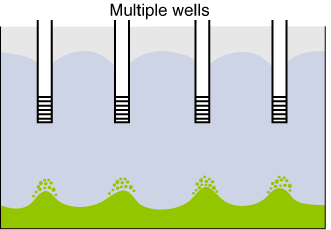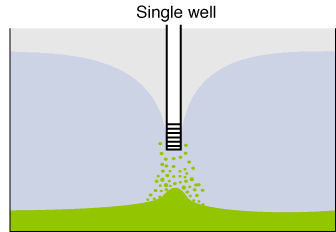

Kansas Geological Survey, Public Information Circular (PIC) 2
Salt Contamination of Ground Water in South Central Kansas--Part 5 of 5
1) Assess Well Location and Surrounding Area--Check with locally knowledgeable people or agencies for saltwater problems in the vicinity of the proposed well. If problems are present, determine whether the source of salt contamination was identified. Investigate a larger area (a few miles) surrounding the proposed well, especially in the upgradient direction. Learn and comply with any local or state requirements or recommendations.
2) Install the Well Carefully--Wells that penetrate a confining bed, encounter saltwater, or are not properly plugged can be major contributors to unnecessary salt contamination. Drilling operations should log wells carefully, monitor water quality, and complete or plug holes according to state requirements for proper well construction and plugging procedures.
3) Design for Minimum Water-quality Impact--Screen wells as shallow as practical and pump slowly to minimize upconing. In areas of known salt contamination of the deeper aquifer, safe pumping may require multiple smaller wells rather than a single large well (see fig. 4). If only one well is used, pumping at lower rates for longer periods of time could be advantageous.
Figure 4--Dispersed, low-volume pumping produces less serious salt contamination than
does concentrated withdrawal.


4) Irrigate Conservatively--Using less water not only preserves the quantity of the resource, it also protects its quality and can prolong the useful life of the well.
5) Test Water Quality and Keep Records--Test for salinity at the beginning and end of each season, and more frequently if a saltwater problem is suspected. If water quality deteriorates, early detection allows time to modify operating or crop patterns and minimize loss.
If saltwater problems are related to drought, climatic conditions should be a factor in water-use planning.
For information and assistance with saltwater-contamination problems, contact the local Groundwater Management District (GMD2 316/835-2224; GMD5 316/234-5352), the Division of Water Resources (316/234-5311), the Kansas Department of Health and Environment (785/296-1500), the Kansas Ground Water Association (316/548-2669), or the Kansas Geological Survey (785/864-3965). The problems, and the appropriate solutions, depend on the source of the salt contamination. The best defense, however, is to avoid problems in the first place by planning new wells carefully and operating existing wells prudently.


Kansas Geological Survey, Geology Extension
Web version Nov. 1995
The URL for this page is http://www.kgs.ku.edu/Publications/pic2/pic2_5.html